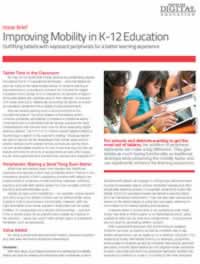For schools and districts wanting to get the most out of tablets, the addition of peripheral keyboards can make a big difference. They give tablets as much typing functionality as traditional desktops while preserving the mobility factor, and can significantly enhance the learning experience. Let Logitech, through GovConnection help. Here are five things to look for in a peripheral keyboard.
Five Things to Look for in a Peripheral Keyboard
Posted By GovConnection On In Retired Whitepapers,Teaching Trends | No Comments
The latest push for competency-based learning
Posted By By Laura Devaney, Managing Editor, @eSN_Laura On In Curriculum,District Management,eClassroom News,Featured on eSchool News,IT Management,News,Teaching & Learning,Top News | No Comments
As personalized learning becomes more in-demand, more educators advocate for competency education
Student-centered learning is at the forefront of many education reforms today, as stakeholders realize that personalizing learning is key to student success. And competency-based learning–the idea that students advance based on concept mastery and not time- or grade-level restraints–is a key part of student-centered learning.
Supporters maintain that education’s design as it is today, which centers around time and curriculum, doesn’t support students the way they need to be supported in order to prepare for a competitive global economy. Critics wonder if all student groups are well-served by the model, and have said there can be too much testing.
“Competency-based education is really foundational for true student-centered learning and personalized learning,” said Susan Patrick, president and CEO of the International Association for K-12 Online Learning (iNACOL), speaking during an April 28 web briefing.
(Next page: What does competency-based learning look like?)
Often called proficiency-based, outcome-based, standards-based, or performance-based education, the core idea is to eliminate time and place as barriers to learning, and this idea is a focus in many state reforms, Patrick said.
Competency-based learning, she noted, is aligned around five key elements:
- Performance: Students advance upon mastery.
- Goals: Competencies include explicit, measurable, transferable learning objectives that empower students.
- Demonstrate: Assessment is meaningful and a positive learning experience for students.
- Feedback: Students receive timely, differentiated support based on their individual learning needs.
- Problem solving/higher order thinking: Learning outcomes emphasize competencies that include application and creation of knowledge, along with the development of important skills and dispositions.
“Competency-based learning is fundamental to being able to personalize learning at scale, and it challenges almost all of our assumptions about the present system,” Patrick said. “When you rethink a system transformation toward competency-based learning, you are literally going to be challenging everything in the system.”
What might such a system look like?
- Every student has a personalized learning map
- Data systems support teachers and students, clearly indicating their level of progress on each academic standard and efficiency standard in order to monitor student progress
- Rubrics help teachers understand what proficiency looks like
- Students know their learning targets and collaborate with each other
- Adults are in shifting roles
“Competency-based learning matters because it flips time into being a resource, and not a constraint,” Patrick added. “It gives us a way to help better serve our students.”
Some states are implementing competency-based frameworks in an effort to personalize student learning and support students’ needs, as noted in A K-12 Federal Policy Framework for Competency Education: Building Capacity for Systems Change [1], an issue brief from iNACOL and CompetencyWorks, which Patrick referenced during the briefing.
New Hampshire was the first state to focus on competency-based education, and since 2005 its education policies have continued to focus on student-centered learning.
State policymakers in Rhode Island have made personalized learning a priority and are focusing on targeted instruction and comprehensive assessments.
And in Detroit, a nonprofit school turnaround organization used a competency-based system when it launched a blended model at A.L. Holmes, a low-performing K-8 public school. Student math and reading proficiency skyrocketed and the model was expanded to other schools.
What education needs now: A national repository of educational materials
Posted By By Carol Lach On In Curriculum,District Management,eClassroom News,Featured on eSchool News,IT Management,Mobile Learning: Strategies for Success,Opinion,Teaching & Learning | 1 Comment
A brave new world of education requires the transition to digital resources
For this to happen we need to build a National Repository of Educational Materials [2] (NREM), an online library of lessons in a range of subject areas with pre-assessments, instructional content and media, practice tasks, quizzes, and mastery tests.
The current high-stakes testing in narrow subject areas is costing us billions of dollars that should be put to better use.
Could we build NREM? There is a precedent. The federal government funded the National Genome Project [3] at a time when technological advances made gene-sequencing possible, but the work was fragmented; competition in the field was rampant.
Yet, the entire human genome was sequenced in a single effort, a coordinated database for all scientists to access worldwide. This made possible exponential progress in science because the common good prevailed.
(Next page: Interactive materials available for all students)
Analogously, the Common Core has spurred a flurry of disparate activities to create texts, units, and lessons by teachers, professors, consultants, publishers, state and local educational agencies, and others. Teachers and students don’t have the materials they need at their fingertips. More than 40 years ago, we had a textbook that was the curriculum, complete with quizzes, tests, and tips in the teacher’s edition. Teachers planned, taught, and focused on their students.
But the world is far too complex, the classrooms of today far too diverse for static textbooks. We need appropriate, engaging materials available for all students: for helping struggling students, for challenging proficient ones and for addressing the needs of all students in between. Many elements of these curricular materials already exist: in published and online texts, teacher-created lessons, YouTube videos, online assessments, reference materials, educational games, etc. They need to be vetted, indexed and made available to everyone.
The intended consequence of NREM is to provide access to an appropriate education for all students. With this tool, students could progress at whatever pace is most suitable to them: delving deeper into areas that interest them and repeating lessons similar to ones they find difficult.
Teachers would finally have the tools for differentiation in their classrooms. The Repository would allow the system to break the mold of education by chronological age. Students would be grouped by progress on mastery tests with specific requirements, as in martial arts. Classrooms would be different.
As communities of learners, students could shine in their areas of strength. Students would learn that practice and perseverance lead to success and recognition. Teachers and student leaders could spend time in small groups, clarifying concepts, discussing issues, making one another think, and providing encouragement for the pursuit of excellence.
Teachers would be empowered as coaches, mentors, progress monitors, and discussion leaders. They would have time to know their students, encourage them, and build on their strengths. Sparking students’ interests and passions is how education will give us future successful citizens.
Carol Lach is a retired educator, a former instructional technology coordinator at the Massachusetts Department of Elementary and Secondary Education and a technology specialist in the Framingham MA Public Schools. She holds a PhD in the sciences and has taught in Ithaca NY and Meridian MS.
Office 365 enhances smooth transition to a Bring Your Own Laptop program
Posted By By Peter West On In Featured on eSchool News,IT Management,Opinion,Teaching & Learning,Top News | No Comments
Peter West, director of eLearning at Saint Stephen’s College in Australia, shares tips for a smooth transition to a Bring Your Own Laptop program
Overview: Experience in a real-life scenario in a K-12 school at the beginning of 2014 demonstrated that an integrated Microsoft environment that leverages cloud based solutions can help an organization to roll out a Bring Your Own Laptop (BYOL) program, complete with the installation of key software, with few problems, in a very short period of time–a day or two.
While it requires planning and development of resources, the final solution is robust and effective. In this example, students experienced few problems, teachers were happy as all students had key software required for learning, and the IT department was “underwhelmed,” instead of being overwhelmed.
The Process
Part of a successful (BYOL) program requires that students have access to software at reasonable prices. An Office suite is an essential part of this software program.
Microsoft makes this easy for educational organizations by providing the Office suite [4] for Windows and Apple laptops at no cost as part of their Student Advantage program, to supplement their Office 365 (O365) cloud suite. This suite incorporates Outlook/Exchange in the cloud, Office Web Apps, Sharepoint in the Cloud (including OneDrive Pro) and more.
In the recent move to a BYOL program, more than 500 students in a K-12 independent school used a largely “self-service” program to install and license the Office Suite over a period of a day or two; support from the IT department was minimal and largely consisted of tweaking a few individual’s firewall settings; settings on individual laptops that prevented a student from accessing the licencing web site.
No installation DVDs of software were used anywhere. No license keys were provided to students. No new user names or passwords were needed.
Students had two methods of downloading and installing the Office Suite. Both were simple and effective as they used the Office Click to run [5] technology.
Simplified installation and updates
The Click to run installation is simplified and requires almost no user intervention, making it ideal for a school environment where students have a range of skill levels. Updates are also done automatically when required to reduce problems, improve security and reduce load on the IT department.
Offsite installation
The “offsite” solution used the Office 365 portal for installation and registration of the software.
It was a remarkably quick and easy solution, with the main components of the Office Suite installing within minutes and the remaining components installing silently in the background.
During the installation, if a user wanted to use a component of the suite that was not yet installed, the process was intelligent enough that it would switch to that component, make it “live,” and then return to the background process of installing the remaining components of the product.
Onsite Installation
An onsite solution was provided to reduce data usage on premise. Rather than download the application via the internet, the installation files were provided on the organization’s network. (These installation files were special Click to run versions of Office). Once a student copied the installation files to his/her laptop, the Suite could be installed normally, with registration then being done online via the Office 365 portal.
This solution ensured that bandwidth was not congested with hundreds of students downloading the Suite at the same time while on campus. Thus, the remainder of the organization could continue to operate normally.
In fact, web access to the installation site was blocked on campus to ensure that students used the locally provided installation files.
Licensing
Licensing software for over 500 individuals using personally owned devices can be time consuming. However, each student registered his/her copy of Office via the Office365 portal using existing credentials; the username and password used to access the College network and all organization resources. This was possible due to integration of the student Microsoft “cloud” accounts with the local College network [6].
Students did not require yet another user name and password, something that is common with “external” web based resources. This reduced confusion and eliminated the need for the distribution of yet another set of credentials to each student. Thus, the overheads for the organization were minimal.
Guides and support
A comprehensive BYOL “course” was also added to the Online Learning Environment (OLE) for the organization. This contained detailed instructions on how to access and install Office, as well as information on a range of other important software and resources.
This course also contained training videos and documents for all of the key software and solutions, including components of Office365 such as OneDrive Pro.
Summary
Integrated software solutions, detailed online support and careful planning and preparation can allow a smooth transition to a BYOL program, providing a solution that enhances education while keeping support problems to a minimum.
Peter West is Director of eLearning at Saint Stephen’s College in Australia. He has over 15 years’ experience leading K-12 schools in technology enhanced education, particularly blended learning using online learning environments. He can be contacted at pwest@ssc.qld.edu.au [7].